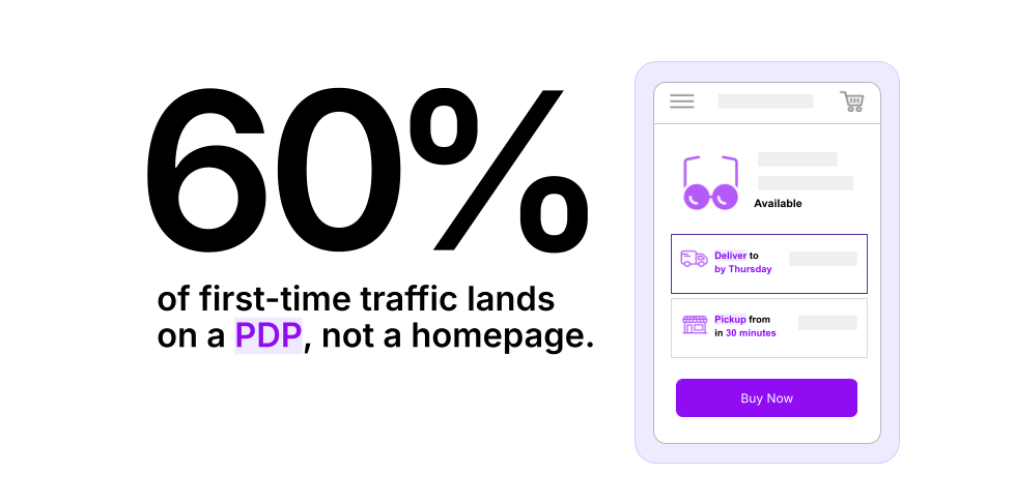The path to purchase has evolved over the past five years. It’s longer and more complex. Consumers start and stop their shopping journeys on a whim. It’s also powered by more organic channels and touch points. Destinations rooted in authentic, and at times aimless, discovery.
New research from CI&T indicates that 55% of consumers still largely go to traditional search engines like Google to conduct research and find the best brand for their needs. But what about the others? They’re gravitating towards more organic and content-driven platforms. For example, Emarketer found that 24% of consumers primarily use social media to conduct searches. Even more consumers (57%) say they use YouTube to hunt for information the same way they use Google.
As a result, consumers’ search queries are becoming more unstructured and trend-based. (Remember how “grandmacore fashion” and “satin skin” flooded social feeds?) Other times, they’re detailed and intentional, referring to certain silhouettes, colorways, and patterns.
These behaviors are contradictory, but both shifts mean consumers are no longer sent to general homepages when they conduct a search. Instead, they’re directed to specific product detail pages (PDP).
The PDP is the new homepage. That means the quality of your PDPs dictates whether consumers spend with you or a competitor.
What Makes a Good Product Detail Page?
Now that PDPs are the most common entry point to your brand, you need to make sure they’re rich and engaging. That means having detailed, SEO-rich content that speaks to shoppers’ needs and behaviors. PDPs need to support:
- Early-stage discovery: When consumers are browsing at the highest level
- Assessment: When they’re investigating and even comparing specific products and their specs
- Confirmation: When consumers want to validate their decisions
Context is key to addressing these goals.
Go beyond basic product specs and share details on materials, manufacturing practices and even whether your products are sustainable. Feature content from creators and consumers who use (and love!) your products. And finally, provide details on how to set up, use, or even pair items with your broader assortment.
In this new era of shopping, details matter. As shoppers venture across search, social and even AI platforms like Perplexity and Chat GPT, you need to ensure your PDPs are up to par.
Here are some ways to prep your PDPs so they align with key business goals and objectives.
PDP Business Goal: Improved Add-to-Cart Rate
The foundation of a successful PDP is rich product information. Details matter here. After all, your shoppers’ search queries are more specific and contextual. For example, a shopper is no longer searching for a “red dress.” She’s searching for “a red dress for a 1920s themed party.” Add keywords and phrases that speak to what’s trending across channels.
You should also add details that speak to a product’s features, benefits and use cases. If you want to make these descriptions even more compelling, you can add in:
- Customer reviews, ratings, and testimonials, along with supporting supporting images
- Rich product images and videos that show items “in context.” That means someone using or wearing the item in real life, not in a staged photo shoot
And if you sell items bought in multiples — think DIY supplies like cabinet hardware, or home goods like cushions and chairs — specify how many items are in each order. Apply safety stock to protect overselling and canceled orders.
To that end, if you want to get customers from research to conversion faster, feature both online and in-store inventory levels. You can drive online urgency by promoting low inventory levels. Or showcase location-specific inventory to drive people to stores. To pull off either scenario, accurate, real-time data needs to be shared between your stores and ecommerce site.
The final step to getting a customer to add to cart is to show estimated delivery dates, not shipping speed. This provides more context and clarity, which drives trust.
PDP Business Goal: Improved Average Order Value for Ecommerce
If you want to boost average order value (AOV), you need to create PDPs that keep customers on-site and engaged with your products. After all, if they spend more time browsing different PDPs, they’re more likely to add items to their carts.
The biggest low-hanging fruit opportunity? Displaying complementary items often bought with the primary item featured on a PDP. This approach is especially effective for apparel, footwear and home decor/furniture brands. When someone buys a pair of sneakers, they’re more likely to buy a new package of crew socks. If someone is looking at a new quilt for spring, they may be more willing to throw in a few matching throw pillows.
You can also use recommendations to educate shoppers on specific projects, trends, or looks. On an eyeliner PDP, you can feature complementary blush, lipsticks and facial highlighter to show a complete dewy summer look. They won’t be able to help but add to cart!
Another way to increase AOV is by showing items that have the same or similar product attributes. For example, displaying tops with similar neck line, sleeve length, silhouette, or pattern inspires consumers to spend more time browsing. They may find a different (more expensive) item that better aligns with their needs.
Regardless of the approach you take, you can further optimize PDPs by showing items that are in stock at the same location, whether it be a store or distribution center. Doing so will help you reduce split shipments and reduce delivery costs.
But crafting an effective PDP takes far more than simply giving customers what they want. Tempting customers with a financial incentive can tap into their inner psyche and create a sense of urgency. Add details about alternative payment options, such as the BNPL apps you accept, to drive impulse purchases. BNPL omnichannel shoppers spend 72% more per transaction than other online shoppers. That’s a lot of revenue potential!
PDP Business Goal: Improved Average Order Value for In-Store Pickup Orders
At the end of 2024, Emarketer estimated there were 150.9 million click-and-collect shoppers in the U.S. That’s more than 53% of the country’s population! Don’t sleep on cross-selling and up-selling to these shoppers. Promote items available at the same location where they will pick up their online order. And if you really want to create urgency, add a call-to-action featuring a timely deal or sale.
Grocery, beauty and personal care brand also have a unique opportunity to tap into shoppers’ habits. By spotlighting in-store items shoppers have previously purchased in-store, you can inspire them to add-to-cart again.
If you want to do either of these things well, you need accurate inventory data.
Turn PDPs into Revenue-Drivers
If you don’t provide rich, optimized content on your PDPs, your customers will quickly go to one of your competitors. In fact, nearly 80% of consumers choose not to buy products because product content is bad or non-existent.
Don’t leave ready-to-buy shoppers hanging. Give them the information they need to make the best decision. That means giving them inventory data to be their true, omnichannel selves.
Fluent Order Management can provide accurate inventory availability data and make strong pickup and delivery promises on your PDP. Contact us today to learn more.



